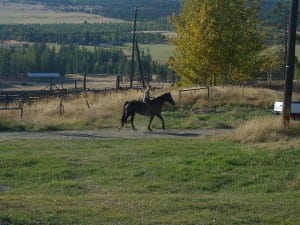“In order to honestly enter a kinetic dialogue with a nonverbal creature, one must join that world. Learning to mirror a horse means learning to think like a horse.” (Mendleshaw, 2008-2009)
Documentation, movement and time spent around horses seemed the most appropriate way to go about developing a horse into my performance, I went to local stables and fields found horses and decided that I should fulfil the criteria I had set. I created a lot of documentation focusing around these horses and concentrated on there limbs and movements and the different living conditions they can appear in.
For example at the site itself some of the stables were abandoned when I first saw them with wildlife growing around and inside them, these aren’t fit for a horse, once again they represented the decay. Yet, they also lead me to an idea, creating a stable inside the cubicles, presenting the decay of one cubicle and the creation of a stable in the other.
I was beginning to create my space and understand what I wanted to craft inside “The act of marking out a performance area is simultaneously the act of declaring that area subject to a different set of rules, even though these rules will not be entirely those of the conventional theatre.” (Wilkie, 2004, 95) With the induction of a dual cubicle concept I was marking out my space, I had begun to explore the endless possibilities I could develop of of it and so began to reimagine the concept of a horse and human, with the documentation I had created I developed more research that took me in the path of interspecies performance. “The animal is the latest figure to be enlisted in the ongoing exploration of identity that has defined progressive politics in the past several decades.” (Chaudhuri, 2004, 39) I had already developed a keen connection with horses and interspecies performance offered me the idea of human and horse as a performer not just an area to be marked out. Animals were in fact a fantastic way to define a message you are trying to send “Animals – ‘trapped in a place of endless misrecognition’… often been defined in terms of lack: of reason, memory, imagination, free will, conscience, language, and so on.” (Williams, 2000, 30) I wanted to show the strength of the horse, how it deserves more from the homosapien than it has received. I wanted to show human decay and how we cause the majesty of a horse to decay.
I began to look at performances surrounding the horse and stumbled across Chasing Canada by Kimber Sider in which she undertook a journey with her horse as one entity and made their way across Canada only by using the directions of people they happened upon. This fusion of Horse and human continued to inspire me in directions I never thought imaginable.

Sider, K. (2008) [Image online] Available from: https://www.flickr.com/photos/ridecanadawest/2924886383/in/set-72157635063339660 [accessed on 29 March 2014]
I decided that I also needed to understand the relationship between human and horses on a more intimate level and so I pulled out my finest suit and went to interview a horse, it did prove to be difficult due to the fact that horses don’t speak a terribly large amount of English. I persevered and decided to study the horses body language as I interviewed it as often most of their dialect is indirect speech.
Horsie Talk Reported by Adam Robinson
This gave me material to work with, I still haven’t decided if I should use this in the actual performance as a way of showing interspecies performance. However, it has lead me to want to understand the history behind horses. I have begun research into myths and legends surrounding equestrians and the decay they have felt throughout the world and I believe it is helping me to begin to develop a narrative.
Performances Cited:
Kimber Sider: Chasing Canada (2008)
References:
Chaudhuri, Una. “Animal Acts for Changing Times: When Does the Non-human Become More than a Metaphor on Stage?” American Theater 21.8 (2004): 36-9.
Mendleshaw, J. (2008-2009) Thinking Like a Horse. The Julliard Journal. [online] New York: The Julliard School. Available from http://www.juilliard.edu/journal/thinking-horse?destination=node/13838 [Accessed 29 March 2014].
Wilkie, F. (2004) Performing (Bore) Place: Rules and Spatial Behaviour. In: Fionna Wilkie. Out of Place, The Negotiation of Space in Site-Specific Performance. Surrey: University of Surrey, 74-101.
Williams, David. “The Right Horse, The Animal Eye – Bartabas and Théâtre Zingaro.” Performance Research 5.2 (2000): 29-40.


